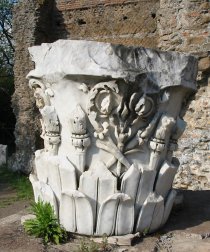The Villa after Hadrian
After Hadrian's death, happened in 130, the villa passed to the Antonini, that took care of it, then in the Ill century, began the decline and the state of neglect: it was stripped of all the valuables. In the time of the gotic war (the 535-553) the villa had to go on foot and here pitched camp earlier the Belisario's bizantine troops, later the Totila's gotic troops. Ten centuries of absolute silence about the villa followed, and the imposing ruins were named "Old Tivoli"; the buildings were crumbled by the neglect and the bad weather, columns and marbles were removed to build Christian basilicas, the statues still remained were used to make lime and the complex became an inexhaustible quarry of building material at Romans' and Tiburtini's disposal (if you move about the medieval quarter on the Hill, you can see columns and bas-reliefes set in the walls and used like materials of construction).
Finally the ruins were covered by the earth on which grew olive trees, now centennial, that confer to the place a new suggestion. After nine hundred years of oblivion this place was again identified as the Adrian's emperor residence at the end of the XV century, under Alexander VI, when the digging campaigns began. In spite of depriving of the previous centuries, the villa still gave a lot of statues (approximately 300) and works of art that enrich the european museums. The searches done in those years and in the following centuries are nothing more than brutal excavation jobs, that marked a "constant, methodical and brutal despoliation", carried out with the single scope to capture more or less valuable materials for the buildings that the rinascimental fervor planed and valuables for the artistic market.
The Villa was frantically inquired by celebrates architects like the Borromini and Pirro Logorio (the latter is famous becouse linked his name to Villa d'Este). They from the discovered structures drew inspiration for their plans, as happened for the famous Villa of Ippolito II of Este. The dispersion of the materials coming from Villa Adriana created an immense gap, becouse currently the archaeological area is appreciated more for the architectonic innovations that for the equilibrium between architecture and furnishings, that is to the base of the Hadrian's decorative program.
Surroundings
-
The Sacro Speco

An impressive complex of buildings which almost looks as if it is one with the surrounding rock...
To know more
-
Rocca Pia
Built on the place where Callisto II Borgia's Castle was situated...
-
Church of St.Peter
It was built on the rests of a roman villa...
Tivoli's attractions

Patrocinio Comune di Tivoli
Assessorato al Turismo



